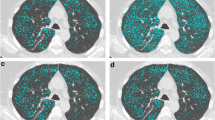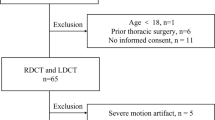Abstract
Objective
This study determined the effect of dose reduction and kernel selection on quantifying emphysema using low-dose computed tomography (LDCT) and evaluated the efficiency of a deep learning–based kernel conversion technique in normalizing kernels for emphysema quantification.
Methods
A sample of 131 participants underwent LDCT and standard-dose computed tomography (SDCT) at 1- to 2-year intervals. LDCT images were reconstructed with B31f and B50f kernels, and SDCT images were reconstructed with B30f kernels. A deep learning model was used to convert the LDCT image from a B50f kernel to a B31f kernel. Emphysema indices (EIs), lung attenuation at 15th percentile (perc15), and mean lung density (MLD) were calculated. Comparisons among the different kernel types for both LDCT and SDCT were performed using Friedman’s test and Bland-Altman plots.
Results
All values of LDCT B50f were significantly different compared with the values of LDCT B31f and SDCT B30f (p < 0.05). Although there was a statistical difference, the variation of the values of LDCT B50f significantly decreased after kernel normalization. The 95% limits of agreement between the SDCT and LDCT kernels (B31f and converted B50f) ranged from − 2.9 to 4.3% and from − 3.2 to 4.4%, respectively. However, there were no significant differences in EIs and perc15 between SDCT and LDCT converted B50f in the non-chronic obstructive pulmonary disease (COPD) participants (p > 0.05).
Conclusion
The deep learning–based CT kernel conversion of sharp kernel in LDCT significantly reduced variation in emphysema quantification, and could be used for emphysema quantification.
Key Points
• Low-dose computed tomography with smooth kernel showed adequate performance in quantifying emphysema compared with standard-dose CT.
• Emphysema quantification is affected by kernel selection and the application of a sharp kernel resulted in a significant overestimation of emphysema.
• Deep learning–based kernel normalization of sharp kernel significantly reduced variation in emphysema quantification.




Similar content being viewed by others
Abbreviations
- CNN:
-
Conversion neural network
- COPD:
-
Chronic obstructive pulmonary disease
- CTDIvol :
-
Volumetric computed tomography dose index
- DLP:
-
Dose-length product
- EI:
-
Emphysema index
- HU:
-
Hounsfield unit
- LDCT:
-
Low-dose computed tomography
- MLD:
-
Mean lung density
- Perc15:
-
Lung attenuation at 15th percentile
- SDCT:
-
Standard-dose computed tomography
References
Snider GL, Kleinerman J, Thurlbeck WM, Bengali ZH (1985) The definition of emphysema. Report of a National Heart, Lung, and Blood Institute, Division of Lung Diseases workshop. Am Rev Respir Dis 132(1):182–185
Soejima K, Yamaguchi K, Kohda E et al (2000) Longitudinal follow-up study of smoking-induced lung density changes by high-resolution computed tomography. Am J Respir Crit Care Med 161:1264–1273
Gietema HA, Schilham AM, van Ginneken B, van Klaveren RJ, Lammers JW, Prokop M (2007) Monitoring of smoking-induced emphysema with CT in a lung cancer screening setting: detection of real increase in extent of emphysema. Radiology 244:890–897
Gevenois PA, de Maertelaer V, De Vuyst P, Zanen J, Yernault JC (1995) Comparison of computed density and macroscopic morphometry in pulmonary emphysema. Am J Respir Crit Care Med 152:653–657
Madani A, De Maertelaer V, Zanen J, Gevenois PA (2007) Pulmonary emphysema: radiation dose and section thickness at multidetector CT quantification--comparison with macroscopic and microscopic morphometry. Radiology 243:250–257
Boedeker KL, McNitt-Gray MF, Rogers SR et al (2004) Emphysema: effect of reconstruction algorithm on CT imaging measures. Radiology 232:295–301
Yuan R, Mayo JR, Hogg JC et al (2007) The effects of radiation dose and CT manufacturer on measurements of lung densitometry. Chest 132:617–623
Lee SM, Lee JG, Lee G et al (2019) CT image conversion among different reconstruction kernels without a sinogram by using a convolutional neural network. Korean J Radiol 20:295–303
Gierada DS, Bierhals AJ, Choong CK et al (2010) Effects of CT section thickness and reconstruction kernel on emphysema quantification relationship to the magnitude of the CT emphysema index. Acad Radiol 17:146–156
Jin H, Heo C, Kim JH (2019) Deep learning-enabled accurate normalization of reconstruction kernel effects on emphysema quantification in low-dose CT. Phys Med Biol 64:135010
Hong Y, Kwon J, Lee S et al (2014) Methodology of an observational cohort study for subjects with chronic obstructive pulmonary disease in dusty areas near cement plants. J Pulm Respir Med 4:169
Bhatt SP, Washko GR, Hoffman EA et al (2019) Imaging advances in chronic obstructive pulmonary disease. Insights from the Genetic Epidemiology of Chronic Obstructive Pulmonary Disease (COPDGene) study. Am J Respir Crit Care Med 199:286–301
Deak PD, Smal Y, Kalender WA (2010) Multisection CT protocols: sex- and age-specific conversion factors used to determine effective dose from dose-length product. Radiology 257:158–166
Wang R, Sui X, Schoepf UJ et al (2015) Ultralow-radiation-dose chest CT: accuracy for lung densitometry and emphysema detection. AJR Am J Roentgenol 204:743–749
Gierada DS, Pilgram TK, Whiting BR et al (2007) Comparison of standard- and low-radiation-dose CT for quantification of emphysema. AJR Am J Roentgenol 188:42–47
O’Brien C, Kok HK, Kelly B et al (2019) To investigate dose reduction and comparability of standard dose CT vs ultra low dose CT in evaluating pulmonary emphysema. Clin Imaging 53:115–119
Shaker SB, Stavngaard T, Laursen LC, Stoel BC, Dirksen A (2011) Rapid fall in lung density following smoking cessation in COPD. COPD 8:2–7
Ashraf H, Lo P, Shaker SB et al (2011) Short-term effect of changes in smoking behaviour on emphysema quantification by CT. Thorax 66:55–60
Jobst BJ, Weinheimer O, Trauth M et al (2018) Effect of smoking cessation on quantitative computed tomography in smokers at risk in a lung cancer screening population. Eur Radiol 28:807–815
Mohamed Hoesein FA, Zanen P, de Jong PA et al (2013) Rate of progression of CT-quantified emphysema in male current and ex-smokers: a follow-up study. Respir Res 14:55
Zach JA, Williams A, Jou SS et al (2016) Current smoking status is associated with lower quantitative CT measures of emphysema and gas trapping. J Thorac Imaging 31:29–36
Gallardo-Estrella L, Lynch DA, Prokop M et al (2016) Normalizing computed tomography data reconstructed with different filter kernels: effect on emphysema quantification. Eur Radiol 26:478–486
Kim H, Goo JM, Ohno Y et al (2019) Effect of reconstruction parameters on the quantitative analysis of chest computed tomography. J Thorac Imaging 34:92–102
Bartel ST, Bierhals AJ, Pilgram TK et al (2011) Equating quantitative emphysema measurements on different CT image reconstructions. Med Phys 38:4894–4902
Ceresa M, Bastarrika G, de Torres JP et al (2011) Robust, standardized quantification of pulmonary emphysema in low dose CT exams. Acad Radiol 18:1382–1390
Gallardo-Estrella L, Pompe E, de Jong PA et al (2017) Normalized emphysema scores on low dose CT: validation as an imaging biomarker for mortality. PLoS One 12:e0188902
Ohkubo M, Wada S, Kayugawa A, Matsumoto T, Murao K (2011) Image filtering as an alternative to the application of a different reconstruction kernel in CT imaging: feasibility study in lung cancer screening. Med Phys 38:3915–3923
Jin H, Heo C, Kim JH (2018) Impact of deep learning of deep learning on the normalization of reconstruction kernel effects in imaging biomarker quantification: a pilot study in CT emphysema. Medical Imaging 2018: Computer-Aided Diagnosis: International Society for Optics and Photonics 2018:105753L
Madani A, Van Muylem A, Gevenois PA (2010) Pulmonary emphysema: effect of lung volume on objective quantification at thin-section CT. Radiology 257:260–268
Funding
The scientific grantor of this research is So Hyeon Bak. This research was supported by the Basic Science Research Program through the National Research Foundation of Korea (NRF) funded by the Ministry of Education (NRF 2018R1D1A1B07049670).
Author information
Authors and Affiliations
Corresponding authors
Ethics declarations
Guarantor
This scientific guarantor of this research is Woo Jin Kim.
Conflict of interest
The authors of this manuscript declare no relationships with any companies whose products or services may be related to the subject matter of the article.
Statistics and biometry
Two of the authors (Sung Ok Kwon and Bom Kim) have significant statistical expertise.
Informed consent
Written informed consent was obtained from all subjects (patients) in this study.
Ethical approval
Institutional Review Board approval was obtained.
Methodology
• retrospective
• cross sectional study
• performed at one institution
Additional information
Publisher’s note
Springer Nature remains neutral with regard to jurisdictional claims in published maps and institutional affiliations.
Electronic supplementary material
ESM 1
(DOCX 19 kb)
Rights and permissions
About this article
Cite this article
Bak, S.H., Kim, J.H., Jin, H. et al. Emphysema quantification using low-dose computed tomography with deep learning–based kernel conversion comparison. Eur Radiol 30, 6779–6787 (2020). https://doi.org/10.1007/s00330-020-07020-3
Received:
Revised:
Accepted:
Published:
Issue Date:
DOI: https://doi.org/10.1007/s00330-020-07020-3




